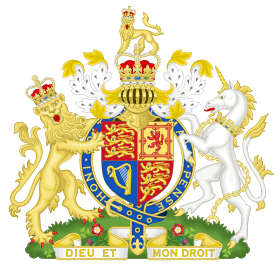Order of British India
The Order of British India was an order of merit established in 1837 by the East India Company for "long, faithful and honourable service".[2] The Company's powers were removed after the Indian Mutiny, and the Order was incorporated into the British Honours System in 1859. The order became obsolete in 1947, after the partition of British India into the Dominion of India and the Dominion of Pakistan.
| The Order of British India | |
|---|---|
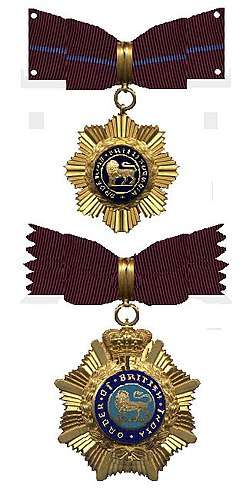 Insignia of the Order, Second Class (above) and First Class, prior to 1939, (below) | |
| Awarded by the British Monarch | |
| Type | Order of merit |
| Eligibility | Officers of the British Indian Army holding a Viceroy's commission, Indian Officers of Indian States Forces, Frontier Corps and Military Police |
| Awarded for | Long, faithful and honourable service |
| Status | No longer awarded after 1947 |
| Post-nominals | OBI |
| Statistics | |
| Established | 17 April 1837 |
| Precedence | |
| Next (higher) | Royal Red Cross (Class II) |
| Next (lower) | Kaisar-i-Hind Medal[1] |
Ribbon 1837–1838 Ribbon 1838–1939 First Class ribbon 1939–1947 Second Class ribbon 1939–1947 | |

The Order
The Order of British India was awarded by the Viceroy of India for long, faithful and honourable service by Viceroy's Commissioned (i.e. native Indian) Officers in the Indian Army. While the Order could be awarded for distinguished service on a particular campaign, it was more often awarded to selected serving officers of between 20 and 30 years service.
Establishment
When first ordered by Lord William Bentinck in April 1837, the Order was intended as a means of providing recognition for serving Indian officers in the East India Company's military forces. These so-called "Native Officers" faced slow promotion under a system that was based on advancement through seniority. The 1st Class of the Order conferred the title of sirdar bahadoor on the 100 subedars and risaldars (senior Indian officer ranks) to whom membership was limited, plus an increase in salary of two rupees a day. Appointments to the 2nd Class, limited to a further 100 Indian officers of any rank, entitled the recipient to the title of bahadoor and a more modest wage increase. In an article published in the Calcutta Review in 1856 Henry Lawrence however expressed the opinion that the Order had become "virtually the reward of old age" with its wearers mostly limited to retired pensioners.
Later history
In September 1939 eligibility was extended to include native officers serving in the Indian States Forces, Frontier Corps and Military Police,[3] and further extended in January 1944 to include native officers and Indian Warrant Officers in the Royal Indian Navy and the Hong Kong and Singapore Royal Artillery, as well as foreign officers, who could be appointed honorary members of the Order.[4]
Appearance
The Order was awarded in two classes, both worn from a neck ribbon:[5]
First Class. The badge consisted of a gold star 1.7 inches (43 mm) in diameter composed of rays of gold with in the centre the words ORDER OF BRITISH INDIA encircling a lion on a background of light blue enamel, surrounded by a laurel wreath, surmounted by a Crown. The enamel behind the wording was dark blue until 1939, when it was changed to the same light blue as appears behind the lion.[5] Recipients of the first class were entitled to use the title Sardar Bahadur (heroic leader).[3]
Second class. The badge comprised a slightly smaller gold star 1.5 inches (38 mm) in diameter of similar design to the first class, but without the crown and with the centre enamel in dark blue enamel. Recipients of the second class were entitled to the title Bahadur (hero).[3]
Holders of both classes could use the post-nominal letters OBI.[3]
All initial awards to the Order were in the second class, with appointments to the first class made from existing members of the second class.[2]
The ribbon was originally sky-blue, but changed to dark red in 1838 after it was found that the hair oil favoured by Indian soldiers stained the ribbon. From September 1939 the first class ribbon had two thin light blue strips added towards the centre of the dark red ribbon, while the second class had one light blue stripe added to the centre of the ribbon.[2]
Pakistan awarded the Order to a small number of seconded British officers who rendered outstanding services at the time of independence.[6][5]
Recipients
The following is an incomplete list of people appointed to the Order of British India:
First Class
- Sardar Bahadur Major General Bakhshish Singh OBI 1st Class June 14, 1912 (Military Secretary Patiala).[7]
- Sardar Bahadur Unjur Tiwari, 1st Bengal Native Infantry. Spied for British forces during the Indian Mutiny.[8]
- Colonel Rao Bahadur Thakur Balu Singh ji Inderpura, OBI, IDSM (1st Class)
 Col Rao Bahadur Balu Singh OBI IDSM
Col Rao Bahadur Balu Singh OBI IDSM - Nawab Mir Hashim Ali Khan, Col Hahsim Nawaz Jung, OBI SB, (1st Class 1897).[9]
- Sardar Bahadur Raja Jeoraj Singh, of Sandwa, CBE, OBI, Major-General in the Bikaner State Forces, Member, Executive Council, Bikaner State, Rajputana.[10]
- Sardar Bahadur Captain Raja Feroz Khan of Gorha Rajgan, O.B.I , Frontier Force Rifles.[11]
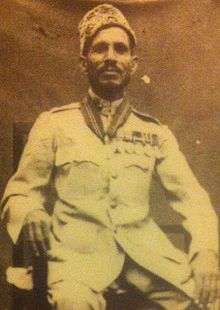
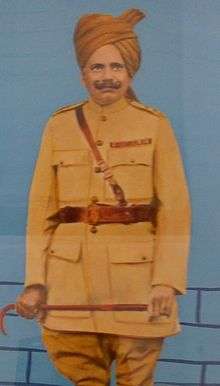
- Khan Bahadur General Fateh Naseeb Khan OBI 1st Class 17 January 1929 (Alwar State Forces).[12]
.jpg)
- Honorary Captain Sardar Bahadur Bhola Singh Gulia, OBI (1st Class), Indian Survey Regiment of Badli, Haryana, India.[13]
- Subadar Major and Honorary Captain Sardar Bahadur Ghafur Khan OBI, IDSM late 4/15th Punjab Regiment.[14]
- Subedar Major and Honorary Lieutenant Sardar Bahadur Pehlwan Khan MBE, OBI, Bronze Star Medal.[15]
- Sardar Bahadur Tiku[16] [17]Singh Thapa, OBI[18], KPM, CM, 2nd in Command, Gurkha Military Police.
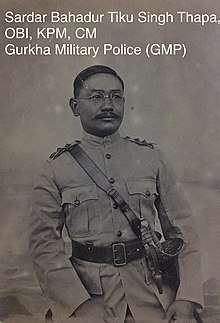 Courtesy Colonel Nitin Thapa (Grandson)
Courtesy Colonel Nitin Thapa (Grandson)
Second Class
- Risaldar Nadir Ali Khan, Bamba Rajput, 9th Hodson's Horse.[19]
- Subedar and Honorary Captain Bahadur Inayat Ullah Asmie, OBI (2nd Class), 10 Baluch Regiment.[20]
- Subedar-Major Bahadur Jagindar Singh, OBI (2nd Class), IOM (2nd Class).[21]
- Subedar Major and Honorary Lieutenant Ram Singh Kaila, Bahadur, IOM, OBI, of 15th Ludhiana Sikhs (1887-1916), 82nd Punjabis (1916-21). IOM for gallantry at Chagra Kotal (Tirah, NWFP, Pakistan).[22]
- Commandant Sardar Bahadur Narain Singh Hundal, OBI 2nd Class, Kapurthala State Forces.[23]
- Risaldar Mir Dad Khan Tarin of 9th Hodson Horse.
Notes
- ORDER OF WEAR, Website of the UK government: Directgov, date accessed 4 January 2018.
- H. Taprell Dorling (1956). Ribbons and Medals. A. H. Baldwin & Son, London. p. 42.
- "London Gazette, 26 Sept 1939, page 6511". Retrieved 4 January 2018.
- "London Gazette, 21 January 1944, page 434". Retrieved 4 January 2018.
- John W. Mussell, editor (2015). Medal Yearbook 2015. Token Publishing Limited, Honiton, Devon. p. 88.
- Edward C Joslin. Observer Book of British Awards and Medals. p. 42. Published by Frederick Warne & Co, 1973.
- "Indian Army List January 1919 — Volume 3".
- Field Marshal Lord Roberts, Forty-one Years in India 1897. Note, page 208.
- Various (15 March 2007). Hyderabad State List of Leading Officials, Nobles and Personages. Potter Press. p. 4. ISBN 978-1-4067-3137-8.
- Singh, Raja Jeoraj. "SUPPLEMENT TO THE LONDON GAZETTE, I JANUARY, 1941" (PDF). www.thegazette.co.uk.
- "Indian Army List January 1919 — Volume 2".
- Various (15 March 2007). Alwar State List of Leading Officials, Nobles and Personages. Potter Press. p. 4. ISBN 978-1-4067-3137-8.
- 33 Years record of unbroken service (1911–1944). Served in both world wars. Madras War Review journal. 21 January 1944.
- "The London Gazette". 20 November 1936. p. 7495.
- Condon, W.E.H. (1962). The Frontier Force Regiment. Gale & Polden. p. 574.
- "File:Sardar Bahadur Tiku Singh Thapa, OBI, KPM, CM, 2nd in Command, Gurkha Military Police.jpg - Wikimedia Commons". commons.wikimedia.org. Retrieved 14 August 2020.
- Thapa, Tiku (February 1937). "Sardar Bahadur" (PDF). Edinburgh Gazette. Archived (PDF) from the original on February 1937. Retrieved 14 August 2020.
- iarchive:in.ernet.dli.2015.169153
- The award of the OBI to him was gazetted in August 1897, as he was one of a special contingent that went to London to present a Guard of Honour to Queen Victoria, on the occasion of her Diamond Jubilee. Naval and Army Illustrated August 1897; also see Indian Army Lists, 1902, 1911
- Captain Bahadur Inayat Ullah Asmi, OBI served in two World Wars, as Subedar and Captain (King's Commission); he died in 1947 in Lahore.
- Subedar-Major Bahadur Jagindar Singh, OBI "" O'Dwyer, Michael Francis (1918). War Speeches. Lahore, Punjab: Superintendent Government Printing. p. 129.
his conspicuous gallantry in action on the 17 November 1914 when with a party of Sappers under the command of a British Officer he was always to the fore and led his men with great determination into the enemy's trenches. Subedar-Major Jagindar Singh, Saini Sikh of Kheri Salabatpur in Bupar, gained the 2nd Class Order of Merit at the battle of Loos in Belgium for striking leadership and conspicuous bravery in action after most of his company and all but one British Officer in his regiment had been killed or wounded. This officer was also awarded the 2nd Class of the Order of British India for distinguished conduct in the field.
- vide GGO No. 430 of 1898. OBI vide Gazette of India No. 872 of 1917.
- https://archive.org/details/in.ernet.dli.2015.510657/page/n149
References
- Peter Duckers, British Orders And Decorations, Shire Publications, Buckinghamshire, 2004
- "No. 34694". The London Gazette. 26 September 1939. p. 6511.
- "Digital Indian Army Lists". Retrieved 8 August 2017.
- Indian Army List - Jan 1920. Retrieved 8 August 2017.
- "Indian Army List - Jan 1931". Retrieved 8 August 2017.
- "Indian Army List - Jan 1941". Retrieved 8 August 2017.
GGO[L/Mil/17/2--- L/Mil/17/5] and the India Gazette [V/II]. And The History of Indian Artillery by Brig Gen Graham.
